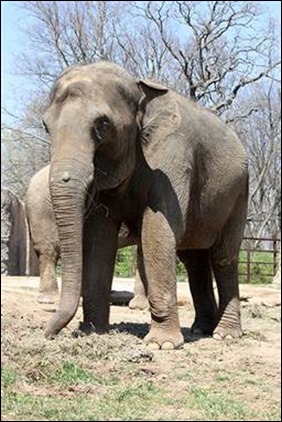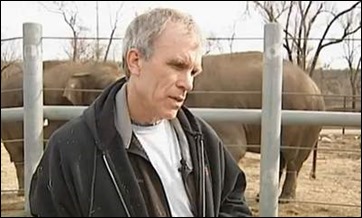Her patience, it seems, finally ran out. Maybe it’s because elephants never forget. And Patience has a lot of bad things to remember – dating back to when, as a baby, she was torn from her family in the forests of Thailand in 1976 and brought to the United States.
Last week, zookeepers euthanized her friend Pinky at the Dickerson Park Zoo in Missouri. The 50-year-old elephant, who humans had kidnapped from her family as a baby, was in kidney failure after suffering from many of the health issues that are common to elephants in captivity.
Elephants grieve deeply for lost friends and family. Perhaps, for Patience, the loss of Pinky was the final straw. She turned on her zookeeper, John Bradford, lunged at him, swinging her head and knocking him to the ground. And she killed him.
This was no accident; this was an angry, distraught elephant with a history of aggression.
Just like Tilikum the killer whale, who has killed three people since being taken from the wild.
Tilikum, the largest orca in captivity, languishes in a small tank at the back of a SeaWorld circus after killing Dawn Brancheau more than three years ago. He’s the subject of the new movie Blackfish, which gets its first nationwide airing on CNN next Thursday.
Like Patience and Pinky, humans tore Tilikum from his mother – in his case off the coast of Iceland as an infant in 1972. When he killed his trainer, Dawn Brancheau, while people who were having dinner at SeaWorld Orlando looked on in horror, it was big news around the country. It still is – which is why the movie Blackfish has been getting so much publicity.
The death of elephant keeper John Bradford at a zoo in Missouri has produced no such uproar. How come?
Orcas are the largest ocean mammals in captivity; elephants the largest land mammal in captivity. Elephants are perhaps the most beloved of all large animals; orcas perhaps the most admired. Both can kill a human in an instant. Orcas have a long and troubling history of killing their trainers – a list that’s been largely hidden from the general public but that’s revealed in Blackfish.
Elephants, too, have turned on their trainers and keepers, but have, for the most part, cowed into submission with the use of painful bullhooks and electric shocks.
Understanding the Point
Like humans, orcas and elephants also have a highly sophisticated level of cognition. Elephants understand what you mean when you point at something.
Last week, researchers published a new study of elephants, showing, once again, just how cognitively complex they are. This latest study demonstrates that elephants understand what you mean when you point at something.
This may seem like no big deal, but in terms of brain power, it is indeed a big deal. Humans can do it, but not until we’re about 18 months old. Dogs can do it – but they’ve been living with us and studying us for tens of thousands of years and they’ve figured out a great deal of what our various vocalizations and gestures mean. Chimpanzees can’t generally do it. Dolphins can, but it takes some training.
And elephants, we now learn, do it quite naturally.
“What really amazed us about the elephants was that we didn’t find any sign that they were learning it [from doing the tests in the study],” said Richard Byrne, a psychology professor at St Andrews University in Scotland. “I think it implies that they knew how to do it in the first place.”
(For a simple description of the study’s methodology, go here.)
If you understand pointing, it means you know what’s going on in someone else’s mind. It means you’ve figured out that when I extend my arm and stretch out one finger, what matters is not my finger but what’s in my mind and what I’m trying to convey to you. You have to be able to see it from my point of view.
Perhaps elephants use their trunks to point things out to each other – we don’t know. But the fact that they understand what we’re doing indicates that they have what’s called a theory of mind – an understanding of what’s going on in the minds of others. Theory of mind is critical to the kinds of multi-dimensional, empathic relationships animals have in complex societies that are typical of humans, dolphins, elephants and great apes. “The special thing about elephants is just how very social and empathic they are.”
“The special thing about elephants is just how very social and empathic they are,” Byrns says. “Something about their social lives and their social understanding is perhaps what has selected for this ability. I think it also implies that they probably ought to show some pointing ability themselves.”
I Know How You Feel
Elephants are also well known for the depth of their grief when they lose friends and family members. In the wild, they can linger over the dead body for days on end, caressing it with their trunks and keeping hungry predators at bay.
So, was the death of Pinky especially upsetting to Patience? Does her memory stretch back to when she was torn from her own mother, who humans quite possibly shot and killed during the abduction of her baby?
English poet John Donne called elephants “nature’s great masterpiece … the only harmless great thing.” And Charles Darwin wrote that many nonhuman animals share such emotions as love, grief, and gratitude, as well as jealousy, deceit, and vengefulness.
Elephants are well known for the depth of their grief when they lose friends and family members.Sparked by grief, was vengeance in the mind of Patience last week?
And, again, the question: Why do we focus so much on Tilikum, but so little of the death of John Bradford at the hand (or head) of Patience?
Perhaps, in part, it’s because we know orcas as “killer whales” so there’s an assumption that they’re dangerous, even though there’s no known case of a killer whale ever killing a human in the wild. By comparison, we think of elephants as “gentle giants,” so we like to think of it as an accident when they attack their keepers. Maybe some of those deaths were accidents. But certainly not all.
Fighting Back
In the wild, too, they’re attacking humans more and more. They seem to know that humans are poaching them to the point of extinction and they’re fighting back. More remarkably, their attacks are not just random; they seem to know which humans are their enemies, and which are not. John Sweeney writes in The Guardian:
The more I read about the massive elephant brain, the more convinced I’ve become, in the words of one psychologist, Graeme Shannon of Sussex University, “there seems to be something going on there.”
He was talking about elephants in Kenya being able to distinguish between different languages – English, safe, the language of tourists clicking cameras; Maa – potentially dangerous, the language of the Maasai warriors who occasionally kill elephants; and Swahili, generally safe. The elephants seemed anxious when someone spoke Maa; the moment she switched to Swahili, they became calm.
The bigger threat now, of course, are the ivory poachers who are part of the enormous trafficking industry of Asia. And the elephants are trying to learn to hide from them, like staying out of sight for much of the day in places frequented by poachers. But let’s not just blame the poachers. Zoos were trafficking in elephants long before the current ivory craze.
Trafficking in elephants
Out of 469 elephants listed by the Elephant Database as being in North American zoos and other entertainment facilities, 337 were captured from the wild in Africa and Asia – forcibly taken from their mothers as infants. All of this abduction, along with the frequent slaughter of their families, is condoned by the Association of Zoos and Aquaria (AZA), the so-called watchdog of the zoo industry that operates more like a trade association for the zoos.
The zoos and circuses, with the AZA giving them cover, like to tell us that they capture these elephants for the cause of conservation. If that were remotely the case, they’d surely have noticed by now that their ever-so-altruistic work isn’t quite working. Elephant populations in Africa and Asia have collapsed in the last 30 years. The great iconic species of truly gentle giants is on the very edge of extinction.
The zoos have been complicit in the destruction of the elephants from the very beginning. Now, with few people to help them, elephants in the wild, along with captive elephants like Patience, may be doing their best to fight back. But without a massive intervention against poachers, traffickers, zoos and circuses, it will be too late.

